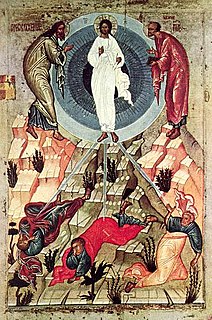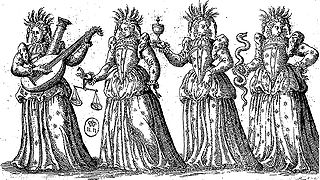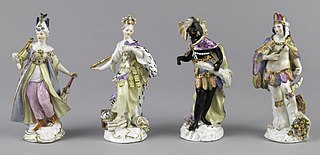
The morality play is a genre of medieval and early Tudor drama. The term is used by scholars of literary and dramatic history to refer to a genre of play texts from the fourteenth through sixteenth centuries that feature personified concepts alongside angels and demons, who are engaged in a struggle to persuade a protagonist who represents a generic human character toward either good or evil. The common story arc of these plays follows "the temptation, fall and redemption of the protagonist."

The seven deadly sins, also known as the capital vices or cardinal sins, is a grouping and classification of vices within Christian teachings. Although they are not directly mentioned in the Bible, there are parallels with the seven things God is said to hate in the Book of Proverbs. Behaviours or habits are classified under this category if they directly give rise to other immoralities. According to the standard list, they are pride, greed, wrath, envy, lust, gluttony and sloth, which are contrary to the seven capital virtues.

Ramon Llull was a philosopher, theologian, poet, missionary, and Christian apologist from the Kingdom of Majorca.

A vice is a practice, behaviour, or habit generally considered immoral, sinful, criminal, rude, taboo, depraved, degrading, deviant or perverted in the associated society. In more minor usage, vice can refer to a fault, a negative character trait, a defect, an infirmity, or a bad or unhealthy habit. Vices are usually associated with a transgression in a person's character or temperament rather than their morality.

Positional notation usually denotes the extension to any base of the Hindu–Arabic numeral system. More generally, a positional system is a numeral system in which the contribution of a digit to the value of a number is the value of the digit multiplied by a factor determined by the position of the digit. In early numeral systems, such as Roman numerals, a digit has only one value: I means one, X means ten and C a hundred. In modern positional systems, such as the decimal system, the position of the digit means that its value must be multiplied by some value: in 555, the three identical symbols represent five hundreds, five tens, and five units, respectively, due to their different positions in the digit string.

Purgatorio is the second part of Dante's Divine Comedy, following the Inferno and preceding the Paradiso. The poem was written in the early 14th century. It is an allegory telling of the climb of Dante up the Mount of Purgatory, guided by the Roman poet Virgil—except for the last four cantos, at which point Beatrice takes over as Dante's guide. Allegorically, Purgatorio represents the penitent Christian life. In describing the climb Dante discusses the nature of sin, examples of vice and virtue, as well as moral issues in politics and in the Church. The poem posits the theory that all sins arise from love – either perverted love directed towards others' harm, or deficient love, or the disordered or excessive love of good things.

The cardinal virtues are four virtues of mind and character in both classical philosophy and Christian theology. They are prudence, justice, fortitude, and temperance. They form a virtue theory of ethics. The term cardinal comes from the Latin cardo (hinge); virtues are so called because they are regarded as the basic virtues required for a virtuous life.

The Scrovegni Chapel, also known as the Arena Chapel, is a small church, adjacent to the Augustinian monastery, the Monastero degli Eremitani in Padua, region of Veneto, Italy. The chapel and monastery are now part of the complex of the Museo Civico of Padua.

Personification occurs when a thing or abstraction is represented as a person, in literature or art, as a type of anthropomorphic metaphor. The type of personification discussed here excludes passing literary effects such as "Shadows hold their breath", and covers cases where a personification appears as a character in literature, or a human figure in art. The technical term for this, since ancient Greece, is prosopopoeia. In the arts many things are commonly personified. These include numerous types of places, especially cities, countries and the four continents, elements of the natural world such as the months or Four Seasons, Four Elements, Four Winds, Five Senses, and abstractions such as virtues, especially the four cardinal virtues and seven deadly sins, the nine Muses, or death.

The Summa Theologiae or Summa Theologica, often referred to simply as the Summa, is the best-known work of Thomas Aquinas (1225–1274), a scholastic theologian and Doctor of the Church. It is a compendium of all of the main theological teachings of the Catholic Church, intended to be an instructional guide for theology students, including seminarians and the literate laity. Presenting the reasoning for almost all points of Christian theology in the West, topics of the Summa follow the following cycle: God; Creation, Man; Man's purpose; Christ; the Sacraments; and back to God.

Cardinal Vicar is a title commonly given to the vicar general of the Diocese of Rome for the portion of the diocese within Italy. The official title, as given in the Annuario Pontificio, is Vicar General of His Holiness.
Miguel Asín Palacios was a Spanish scholar of Islamic studies and the Arabic language, and a Roman Catholic priest. He is primarily known for suggesting Muslim sources for ideas and motifs present in Dante's Divine Comedy, which he discusses in his book La Escatología musulmana en la Divina Comedia (1919). He wrote on medieval Islam, extensively on al-Ghazali. A major book El Islam cristianizado (1931) presents a study of Sufism through the works of Muhyiddin ibn 'Arabi of Murcia in Andalusia. Asín also published other comparative articles regarding certain Islamic influences on Christianity and on mysticism in Spain.
Emo of Friesland was a Frisian scholar and abbot who probably came from the region of Groningen, and the earliest foreign student studying at Oxford University whose name has survived. He wrote a Latin chronicle, later expanded by his successors Menco and Foltert into the Chronicon abbatum in Werum.

The ceremonies and festivities accompanying a formal entry by a ruler or his representative into a city in the Middle Ages and Early Modern Period in Europe were known as the Royal Entry, Triumphal Entry, or Joyous Entry. The entry centred on a procession carrying the entering prince into the city, where he was greeted and paid appropriate homage by the civic authorities, followed by a feast and other celebrations.

Theatrum Chemicum is a compendium of early alchemical writings published in six volumes over the course of six decades. The first three volumes were published in 1602, while the final sixth volume was published in its entirety in 1661. Theatrum Chemicum remains the most comprehensive collective work on the subject of alchemy ever published in the Western world.
The Assembly of Gods is a fifteenth-century dream vision poem by an unknown author. The poem, which includes many of the standard allegorical forms of its day, was quite popular when it was first published in printed form by Wynken de Worde, but has since fallen out of favor.

Inferno is the first part of Italian writer Dante Alighieri's 14th-century epic poem Divine Comedy. It is followed by Purgatorio and Paradiso. The Inferno describes Dante's journey through Hell, guided by the ancient Roman poet Virgil. In the poem, Hell is depicted as nine concentric circles of torment located within the Earth; it is the "realm ... of those who have rejected spiritual values by yielding to bestial appetites or violence, or by perverting their human intellect to fraud or malice against their fellowmen".

Greed is an uncontrolled longing for increase in the acquisition or use of material gain ; or social value, such as status, or power. Greed has been identified as undesirable throughout known human history because it creates behavior-conflict between personal and social goals.

The Proverbia Grecorum is an anonymous Latin collection of proverbs compiled in the seventh or eighth century AD in the British Isles, probably in Ireland. Despite the name, it has no known Greek source. It was perhaps designed as a secular complement to the Hebrew Bible's Book of Proverbs.


















